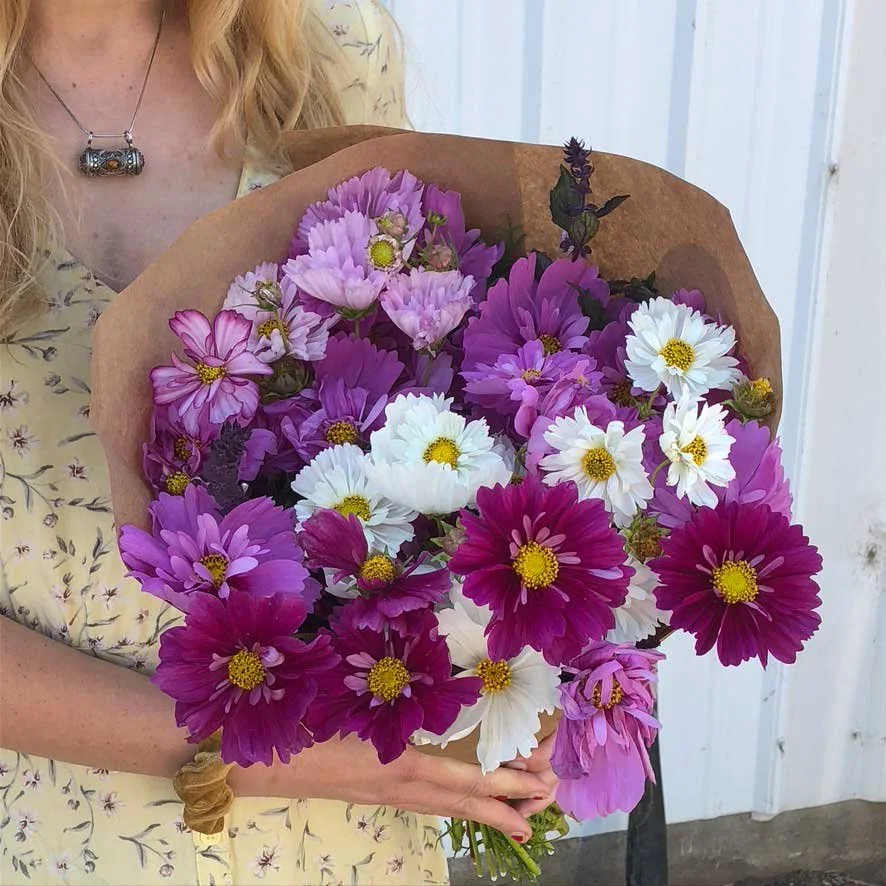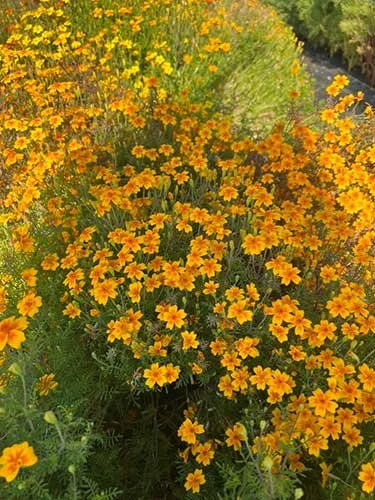Easy to Grow Flowers That You Can Start From Seed Right Now
We are finally right at our frost safe date here on the Palouse. It’s the time when we can breath a sigh of relief and feel pretty confident that summer is here and warm days are ahead. Even though our season is really short and it seems late, there’s still plenty of time to start warm season tender annuals for abundant blooms this summer.
We get annual plant starts going in many ways around here. But, nothing beats direct seeding right into the ground for strong healthy plants. They’ll get right to the business of blooming without the setbacks of transplanting.
There are a few warm season annuals that grow so quickly that you can tuck them into your garden now and expect blooms in no time. If you missed out on special ordering seeds, you can find many of these favorites at the grocery store or anywhere that sells packets of seeds in the spring.
Cosmos
Cosmos are crazy easy to grow. Their time from planting to blooming is so short that you can continue starting them deep into June and still enjoy plenty of blooms.
They are a “cut and come again” garden favorite that add so much character to arrangements. They come in many textures and colors and will freely re-seed in your garden during the season.
Once the plants are about 8” tall, pinch off the top growth down to the next node to promote branching and more flowers.
A luscious bouquet of cosmos and Aromatto - a decorative basil, all direct seeded in late May and early June.
Aromatto Basil
There are basils for cooking (I grow those too!) and basils for looking. Aromatto is a gorgeous filler green that I love to use in my floral work. It has dark foliage that adds interest to designs and it puts up stalks of seed pods that are a must have for my work in the fall. They add an amazing fragrance to your bouquets.
Although they don’t have a strong basil flavor like a Genovese, they are still edible and delicious. After I’ve enjoyed them with my flowers, they often go into an impromptu pesto.
Pinch it early for bushier growth and more beauty to cut later.
Decorative basil in the field. I love the seed heads and its dark purpley-green foliage
Zinnias
There has been so much work on hybridization for this flower that you have endless choices for colors, sizes and textures. If you had to pick only one flower for your cutting garden, this is it.
This cutting garden classic does best when direct seeded. I’ve learned, the hard way, that transplanting zinnia starts sets them back enough that the direct seeded plants always catch up and they bloom at the same time anyway. They are like the aggressive driver who tailgates, passes you in a huff and then you gently pull in behind them at the next stop light.
The only reason to start zinnias ahead of time indoors is if you have a big problem with slugs or voles that mow down tender little plants. In that case, it makes sense to get them strong before putting them out.
Zinnias benefit from a pinch early in the season. Like cosmos, they are a cut and come again flower that will keep you in blooms until frost.
An arrangement of zinnias and marigolds all direct seeded at the farm
Marigold
Like ZInnias, marigold breeding has come a long way. They come in a dizzying array of sizes and shapes. While they don’t come in every color of the rainbow, there are still many hues within their warm white to yellow to orange range. We love the giants that come in yellow, orange, white and tangerine. And we can’t live without tiny fairy like clouds of flowers from the Gem series.
Although they are a cut and come again flower, we do plant marigolds in succesion every three weeks. We start two successions indoors and direct seed the final one. You can skip straight to direct seeding to have success this year with no trouble.
Marigolds do better with a pinch.
We love to string marigolds into garlands and use them for table runners or hang them everywhere.
Tangerine Gem is a must grow marigold at the farm. It makes clouds of tiny flowers that add sparkle to our arrangements, it smells amazing. And because every part of the plant is edible, it’s a go to for garnishing charcuterie boards around here. Gems come in tangerine, orange and lemon colors.
Unlike their larger cousins, Gems are NOT cut and come again. They are a one hit wonder that I harvest right down to the ground when they’re ready.
Amaranth
Amaranth is an easy to grow plant that produces plumes of tiny grains in a range of colors. They add beautiful texture to arrangements and are a go to for our fall designs. Some varieties, like Coral Fountains and Love Lies Bleeding, produce cascades that are lots of fun to tuck around the rim of your vase as a foundation to your design.
Amaranth sometimes sends up a few side shoots after you cut it. But, for the most part, it is a one and done plant. For that reason, it is a good idea to plant a little bit every few weeks for a continuous harvest. We start two waves of plantings in cell trays indoors and direct sow the final succession right into the field.
You’ll have a lot more material to cut if you pinch the plant when it is about a foot tall. We’ve also started planting it much closer together than is advised to keep the seed heads small. We prefer that for our arrangements.
The big giant ones are gorgeous for sure. So go for that if you have a large container where you can feature them in a dramatic display.
My favorite amaranth, Hot Biscuits, mixed with seed pods in a fall bouquet.
A cascading amaranth called “Emerald Tassels” drips around the edged of a vase adding a lot of interest to this design.
Some Grasses and Seed Crops
Some decorative grasses are perennials, and many are cool season annuals. But, we have found one warm season annual grass that does beautifully when direct seeded. Try out “Green Drops” for an element of texture to your designs. It’s really easy to grow and is nice to use fresh in summer arrangements and dried in fall wreaths.
Green Drops is an easy to grow warm season grass that is a versatile addition to your floral designs.
Millet is another easy to grow grain that adds beautiful color and texture to our late summer and fall designs. It is only 84 days from planting to cutting so you can plant it out every few weeks for some time. The first time I grew it, I planted it all at once early in the season and was disappointed that it was all gone when I wanted some for my fall designs. I’m telling you now because I learned so you don’t have to.
Highlander Millet at the perfect harvest stage. While the texture is great, it’s bronzy color is amazing.
Sunflowers
You’ve probably heard me describe sunflowers as a cool season annual. They are. But, many of them have a very short planting to bloom time frame, which means you can still plant them now. We continually sow sunflowers every few weeks until July so that we have blooms until frost and you can too.
Keep in mind that sunflowers come in two types: branching and single stem.
Branching sunflowers need a pinch. They get very large and will send out side shoot blooms after you cut them. Second cuttings are not as good as the first, but they will keep producing. They need to be planted a good 12 inches apart from one another and might require some support.
Single stems should not be pinched. And, as the name implies, they produce a single flower. Many of them are stunning and well worth growing for just the one bloom. Quite a few are dwarf varieties, making them lots of fun in a mixed garden. They can be planted quite close together. We’ve found that the closer you plant them, the smaller the bloom. Because I don’t want big honking flowers for the kind of work I do, we smash them in a lot closer than is advised and it works for us.
These “Teddy Bear” sunflowers are an adorable dwarf single stem variety. Although they are in the one hit wonder category, they put out multiple blooms from their one stem. They add texture and charm to arrangements and are on our must grow list every year.
We’re putting in big days out in the field now for that big pay off later. Lucky for you, you don’t have to put in crazy farmer hours to have a vase of beauty on your dinner table every night. Use this list to find seeds now, tuck them in and enjoy them all summer.









